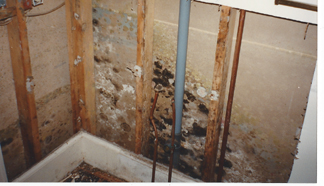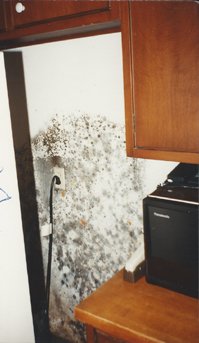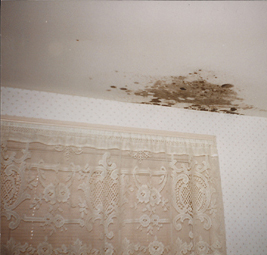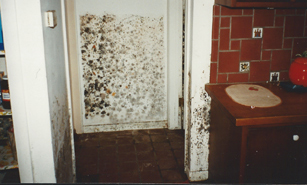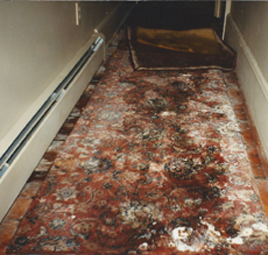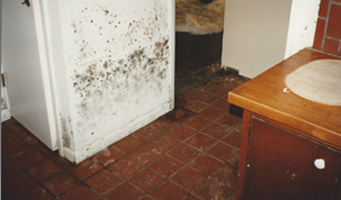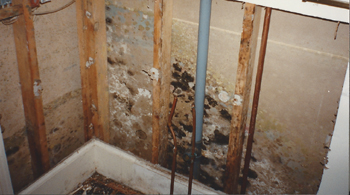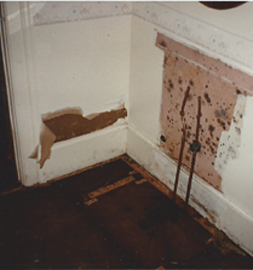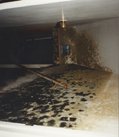Mold and Mildew
Mold vs. Mildew
The terms mold and mildew are often used interchangeably. They are indeed similar but not really the same. It is important to understand their similarities and differences before attempting to prevent their occurrence or to clean up or remediate after finding them in your home or business.
Both organisms are a form of fungus. Mildew is actually a type of mold. They are members of a large variety of micro-organisms which include fungi, algae, rusts, yeasts, and bacteria. The ability to exist on just about any type of material (as long as there is organic material on it) gives these micro-organisms the dubious distinction of being called the chief agents of deterioration.
The color and texture of mold and mildew are also ways to help distinguish each of them. Active mold is usually red, green, blue, and black and tends to be fuzzy and slimy. Mildew is usually powdery and most commonly comes in gray and white.
Mildew thrives on surfaces where moisture content is very high. Examples are ceilings, walls, floors, window sills, leather, and paper, etc. Mildew is usually the culprit in showers, bathtubs, sinks, and toilets. There is even a type of mildew that is specific to wool carpets and rugs! A certain type of mildew can be found as yellow spots on leaves or fruits.
While mold can survive on non-living materials such as tile and plastic as well as on plants, mildew specifically seeks out animal and plant goods and is especially devastating to crops.
Regardless of the particular organic material that may be present, neither mold nor mildew can resist surfaces where there is moisture. They both prosper in dark, humid, damp and poorly ventilated environments.
Mold and Mildew Are Invisible and Odorless!
Does it surprise you to know that mold and mildew are invisible and odorless?! What are those black, green, yellow, etc. spots then? And what about that moldy odor? What you are actually seeing and smelling is the end result of the digestive process of these micro-organisms as they eat through your organic possessions.
Both mold and mildew, since they are forms of fungi, do not need to derive their energy for growth from light. Instead, they need organic materials to supply their nutrients.
How Do Mold and Mildew Spread?
Both mold and mildew spread by sending out massive amounts of spores (or seeds) that are always present in the air and are spread by air currents.
Once landing on a host material, the spores must find sufficient moisture and food to germinate. If the spores cannot find moisture, they will remain in the air, lying dormant until moisture occurs.
Are Mold and Mildew Dangerous for Humans?
Mold and mildew cause many problems for humans. In particular, they can escalate asthma and allergies and mold can cause serious fatigue.
Beneficial to Humans?
Although all mold can cause ill effects, some molds actually have beneficial uses in the scientific and food industries. Molds are used in the production of some medicines such as penicillin, as well as some cholesterol lowering drugs and even some immune-suppressant drugs.
Molds are also used in the production of foods such as cheese, bread, soy sauce, etc. Molds are also essential for our environment for their role in breaking up waste and dead matter and thus helping in the fertilization of soil.
Mildew does not seem to have any beneficial uses at all.
What Do You Need To Do To Prevent Mold and Mildew?
CONTROL of and MONITORING of RELATIVE HUMIDITY
This is of the utmost importance in the home or business environment.
Relative humidity should always be kept below 65%. It is much less likely that spore germination will occur at around 45% to 55% relative humidity.
Since most home dehumidifiers only go to 50%, in problem situations of high humidity, such as a damp basement, it may make sense to invest in a commercial dehumidifier. A temperature between 64 and 68 degrees F. should also be targeted.
Any conditions that raise humidity levels need to be remediated. Some of these may be leaking pipes, gutters and downspouts, leaking roofs, cracked walls or windows, etc.
Proper humidity and temperature controls decrease the possibility of germination and thus growth of mold and mildew.

AIR CIRCULATION
It is of equal importance to maintain adequate air circulation, such as with a fan (especially in bathrooms). Moving air evaporates moisture. Caution: Do NOT use fans if mold is suspected to already exist so as not to disturb the spores and send them airborne.
CLEAN REGULARLY
In combination with lowering humidity levels, the home or business environment should be cleaned regularly to remain as free as possible of dust, dirt and organic debris that can feed spores.
REMOVE ONE OF 4 FACTORS
Spore growth needs moisture, high temperature, high humidity, and a food source to grow. Removing any of these four factors will deter their growth.
After moisture is gone, the invisible spores will go searching again. To prevent their landing and growth, fans can move the air to keep evaporating moisture. Leaving a light on in the affected areas will also help.
Procedures to Follow For General Prevention
Although there is no way to entirely eliminate all molds and their spores in the indoor environment, there are many ways to help control mold growth in your home or business.
1. Stop any water intrusion from leaky pipes, non water-resistant building materials, rain water, etc.
2. Clean fabrics often and keep them in well-ventilated areas.
3. Reduce moisture with dehumidifiers and open windows or use air conditioners (in hot weather) with the goal of keeping the relative humidity in your home or business environment below 40%.
4. Check regularly in problem areas such as bathrooms or laundry rooms for moldy–smelling odors. Disinfect with a 10% solution of sodium hypochlorite (bleach) mixing 1 1/4 to 1 1/2 cup of bleach to a gallon of water. A commercial disinfectant may also be used.
5. Cover any dirt floors in basements with plastic in order to slow down the water vapor that comes through the soil.
6. Make sure your kitchen and baths have ventilation fans and periodically check to make sure they are venting to the outside and that they have not become disconnected or blocked.
7. Dryer vents can be a real problem. Make sure they are attached securely to the dryer and are venting to the outside. The vent duct can accumulate lint and should be cleaned at least once a year and checked for any holes that might leak air.
8. Have your heating and cooling system in your home or business checked to make sure it is the correct size and that it is working properly to remove humidity. Also check your duct system for any air leaks.
What If You Find Mold or Mildew in Your Home or Business?
- Take out anything that has mold or mildew on it.
- Kill any remaining mold or mildew with a mildicide.
- Vacuum everything.
- Replace cardboard containers with plastic bins but make sure to position small boards on shelves under the bins in order to allow for continued air flow.
- You may want to spray walls with a commercial sprayer containing 10% sodium hypochlorite (bleach).
Unfortunately, none of these actions will kill the spores so continuous monitoring of these areas is still necessary.
What Should You Do When a Flood Occurs?
Floods are a major cause of mold and mildew growth. Mold and mildew will begin to develop within 24 to 48 hours of any water exposure in the home, such as flooding, leaks, sewage back-up, overflows, etc. Mold and mildew will continue to grow until the source of the moisture is dealt with.
For detailed information on what steps to take as soon as a flood occurs, please click here.
How to Get Rid of That Lingering Moldy Smell
After you have followed the steps above to control or rid your home of mold spores, what can you do to remove the moldy smell from articles that have been damaged by mold?
Please click the following for an excellent and informative article on How to Get Rid of Mold Smell. The procedure for each type of area or article that has the odor is well explained.
Back to Articles
Back to Homepage
"The Cleanest Clean You've Ever Seen."
by
ABC Oriental Rug & Carpet Cleaning Co.
130 Cecil Malone Drive Ithaca, NY 14850
607-272-1566
